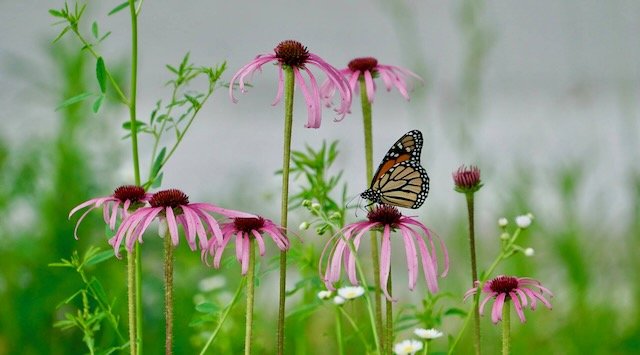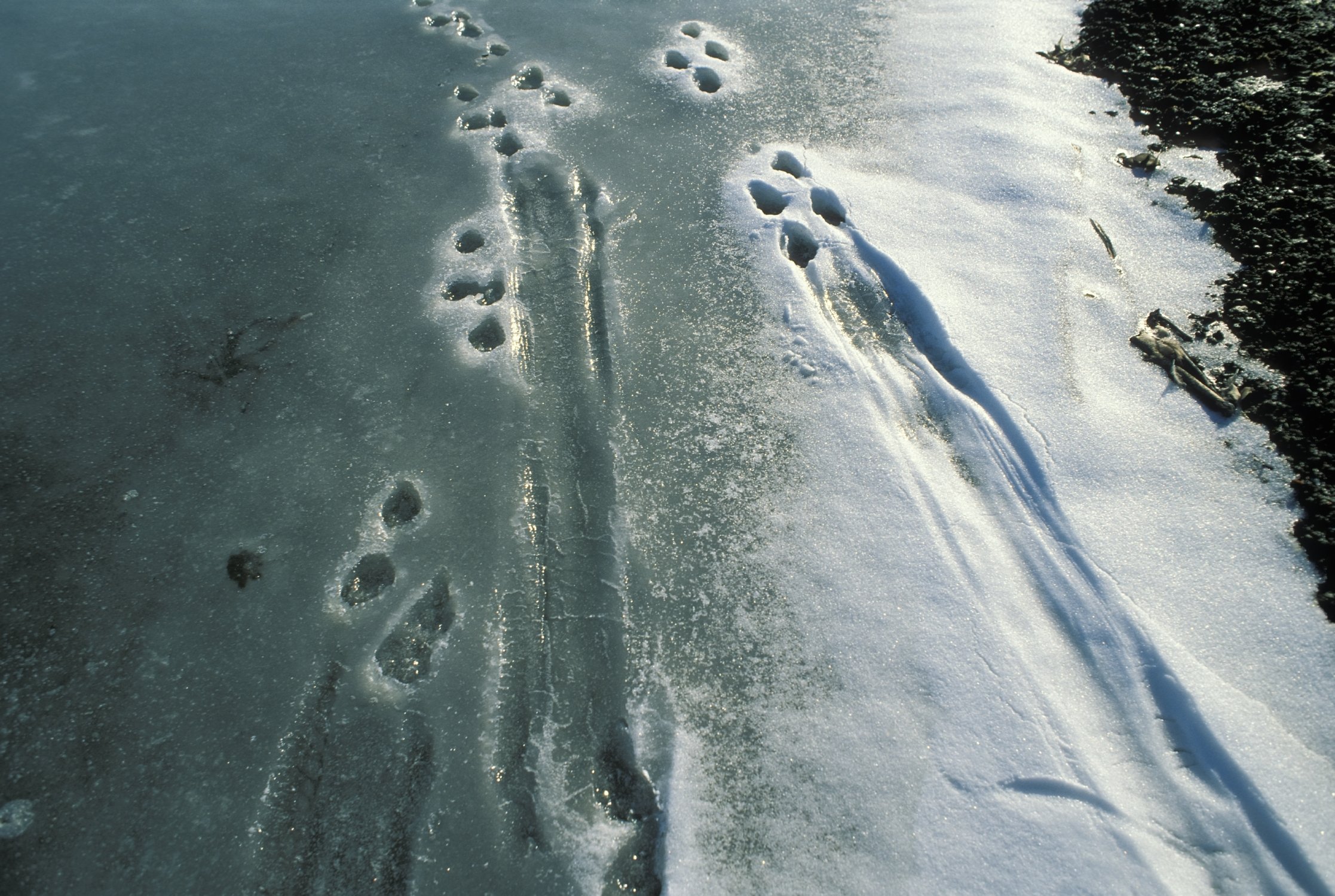Look to the sky, all around SW Missouri, and in your own garden for evidence of Monarch Migration!
Romps and Convocations are Going Strong in Missouri's Wilds
Field notes by J. Cantrell, photos courtesy of the MO Dept. of Conservation
Years ago, I was working an Eagle Day event at Schell Osage Conservation Area (near El Dorado Springs). These were extremely popular events with the public and school groups coming to view Omega or Phoenix, who were rehabbed eagles from the Dickerson Park Zoo, and to see wild eagles in their natural habitat. I staffed spotting scopes along the wetland and set up an area to let people view eagles perching in the treetops or on the lake’s icy surface. Unfortunately, eagles were firmly on the endangered species list then, and out of protected areas, in ideal habitat, they were rather rare for Missourians to see. Visitors eagerly lined up at the optics and I could tell by their facial expressions when they had a full view of our national symbol. They were thrilled at the view and slowly would step back and use their own binoculars to scan for other eagles on their own. The spotting scope outreach conservation event piqued interest and now they were open to learn a little about the habitat and the role the eagle plays in the environment. The observations of a kettling group of eagles riding the thermals in the midday sunshine are called a “soar” of eagles, and perhaps bringing the most interesting eagle behaviors is when they are grouped together on the ground either resting or feeding. A gathering of bald eagles like this is called a “convocation,” and it is thrilling. Educational steps in a simple form of exposure like this was one of the keys to bringing the bald eagle back from critically low numbers. Exposure may lead to a little understanding and, in turn, more understanding.
River Otters & their tracks
That same day at Schell Osage many of my audience members got to witness another comeback performance…river otters. We were fortunate enough to have a mother otter and four teenager otter pups come through the waterways behind the groups of people waiting for their turn at the scopes. On snow-covered land or frozen over lakes, otters travel by alternating running and sliding. Otters swimming together have an uncanny resemblance to sea life mammals; they surface often at unpredictable places. They may bob up or even come ashore briefly to get a better look at their surroundings and “touch base” with otter siblings. They are amusing to watch, thus a group or family of otters on the move are called a “romp” due to their playful nature. Rarely do we catch them resting together, but if so – their grouping is referred to as a “raft.” Historically, otter numbers were decimated by unmanaged harvesting, habitat destruction, and water pollution. That day years ago was when I witnessed people’s excitement and celebration of otter success as well. Since then, over the last 25-30 years river otters have steadily, slowly increased and filled their habitat niches. The otter is an extraordinary animal to learn about and discover in the wild. Over the past year, I’ve had nine different accounts of people visiting with me and sharing photos and videos of otters. Surprisingly their stories were very similar to the Schell Osage account …a group of otters traveling, playing, and even sliding together. Otters are one of the most intelligent mammals in North America and a naturalist observing them will quickly pick up on their body language and verbal communication skills. Predators are vital to a healthy ecosystem and the river otter is an efficient predator of freshwater clams, crawdads, and certain stream fish.
February is a wonderful time to easily view bald eagles in the wild and to happen upon otter signs along the rivers and wetlands. I hope to catch you out in the wilds this month and enjoy the conservation successes of these comeback species! - Jeff
Cheers to 2022!
Wishing you a happy New Year! May it be filled with new adventures and good fortunes.
Water is a Cherished Resource
Water is an extraordinary and multipurpose topic. It is vital for human health, economics and the systems of the environment.
Be Bear Aware, as Black Bears are on the Move!
Tips to avoid attracting black bears to possible human-created food sources:
Lend a Hand to Reversing the Trend
The world is endanger of losing the migration phenomena that has captivated people’s inspiration for generations upon generations.
The Winter Secrets of Nightfall
This month is just the thing for staying active, staving off some sedentary habits, and unquestionably enjoying some nature study.
A Table’s Tie to the Land
Autumn hikes and many customary Thanksgiving holiday icons reminds me of passages from the book A Sand County Almanac. Author Aldo Leopold mentions, “There are two spiritual dangers in not owning a farm. One is the danger of supposing that breakfast comes from the grocery, and the other that heat comes from the furnace.” We are under this covid virus pandemic and the situation has made many of us reflect on our legacy and share family traditions and sentiments of nature, even more.
One of my favorite things to do is backpack and travel. Several years ago I trekked across Germany, Austria and the Czech Republic and discovered scores of similarities comparing their forest make-up to ours. I noticed several familiar plant families and mushrooms on their forest floor which have “kin” over here in the Midwest. And being of a woodsmen persona, I admired their hunting and gathering heritage reflected in fireplace mantels, carved doors, old wooden clocks and banisters, in addition to imagesin tapestries of deer, grouse and waterfowl.
So much of their culture in the countryside reminded me of my youth in Ozarks and the warm friendly people were reminiscent of many of my grandparents’ siblings and cousins. It was incredibly widespread for my relatives and rural people in Missouri to ask if you’ve eaten and feed you first! After we’ve eaten, we could visit more or do projects later, but a warm comfort meal was priority. Backpacking the Black Forest and other parts of Germany brought heartfelt memories of people’s tie to the garden, foraging in the forest and having wild game. I had grown up with two sorts of old world woodsman’s culinary fixings and I didn’t know its roots. I found “Hunter Style” which was a gravy dominated dish and was savory with sautéed mushrooms, onions, and root vegetables. The second type termed “Housewife” was fresh and lighter with apples and sweetened onions. Everything balanced on the plate and both styles seemed lean, yet hearty. I loved it.
Now, I’m home in the western Ozarks. I commonly come across people and sportsmen events’ publication who convey they love venison, but usually all they cook is chili or have summer sausage made from the lean cuts. My globetrotting advice (which nowadays resonates from ol’ Midwest culture too) is take advantage of this extra “kitchen time” the 2020 pandemic has given us. Try some old world cooking recipes with our fresh deer meat this autumn. If you don’t hunt, maybe you’ll be lucky enough to receive some gifts of venison. A Dutch oven simmering a couple pounds of half-inch trimmed deer cutlets, plenty of grocery store- whole button mushrooms, minced garlic, fresh ginger and course black pepper to taste, and equal amounts of tomato paste and red wine is one of my “go-to” recipes. Also trying different marinades on loin or roast cuts is rewarding and you may try the Dutch oven broth on the side dish of greens and root vegetables plus butter (yum). All of this with time to reflect with thanksgiving to the wildlife and garden resources, the time honored hunting heritage and the good people we share the meal with on a November evening. We hope to be grounded by our relation to the land, traditions of family and culture. Happy Thanksgiving and good harvest to all! - And in the tradition of Leopold, let us read some stories nature has to tell out on the trail. Good trails! Jeff
Jeff Cantrell is a conservation educator with the Missouri Dept. of Conservation, housed at Shoal Creek Conservation Education Center, Joplin, MO.
White Tail Deer - photo by Amy Watts
Naturalists Voice
Shoal Creek
Nature Moments!
Seasonal changes are near. What will you see out there?




